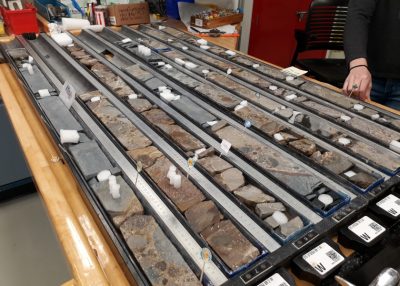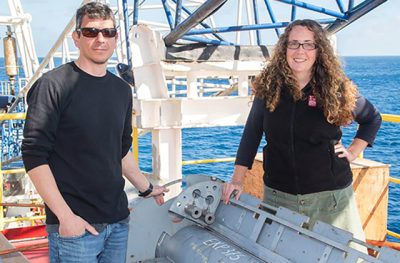Eclectic Rocks Influence Earthquake Types
November 12, 2020

New Zealand’s largest fault is a jumble of mixed-up rocks of all shapes, sizes, compositions and origins. According to research from a global team of scientists, this motley mixture could help explain why the fault generates slow-motion earthquakes known as “slow slip events” as well as destructive, tsunami-generating tremors.
“These rocks that are being mashed up together all behave very differently in terms of their earthquake generating potential,” said Laura Wallace, a research scientist at the University of Texas Institute for Geophysics (UTIG) and co-chief scientist on the 2018 expedition that retrieved the rock samples.
The finding, described March 25, 2020, in Science Advances, is the latest discovery to emerge from two scientific drilling expeditions conducted in 2017 and 2018 in New Zealand and led by UT scientists and colleagues at institutions in New Zealand.
Subduction zones are where the world’s largest and most damaging earthquakes occur. Scientists have long debated why quakes are more powerful or more frequent at some subduction zones than at others, and whether there may be a connection with the slow slip events, which can take weeks or months to unfold.
To answer these questions, scientists led ocean drilling expeditions off the coast of New Zealand, where they recovered rocks from the vicinity of the tremors’ source by drilling into the remains of an ancient sea mountain.
“The earthquake and geological science community has speculated about what goes into a subduction zone where slow earthquakes occur, but this was the first time we’ve literally held those rocks — and physical evidence for any of those ideas — in our hands,” said UTIG Director Demian Saffer, who was co-chief scientist on the 2018 expedition.

Efforts to understand the connection between slow slip events and more destructive earthquakes are already underway. These UTIG-led studies include detailed seismic imaging of the slow slip zone in New Zealand and an ongoing effort to track the behavior of subduction zones around the world by installing sensors on and beneath the seafloor. The goal of the work is to develop a better understanding of the events that lead up to a slow slip event versus a tsunami-generating earthquake.
The research was supported by the International Ocean Discovery Program; New Zealand’s Ministry for Business, Innovation & Employment; NIWA; and GNS Science.
Back to the Newsletter